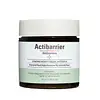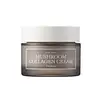What's inside
What's inside
 Key Ingredients
Key Ingredients

 Benefits
Benefits

 Concerns
Concerns

 Ingredients Side-by-side
Ingredients Side-by-side

Hydrogenated Polydecene
EmollientCetearyl Alcohol
EmollientNiacinamide
Smoothing1,2-Hexanediol
Skin ConditioningEctoin
Skin ConditioningPanthenol
Skin ConditioningCetearyl Glucoside
EmulsifyingGlyceryl Stearate
EmollientPentylene Glycol
Skin ConditioningPolymethylsilsesquioxane
C12-16 Alcohols
EmollientPalmitic Acid
EmollientButylene Glycol
HumectantHydrogenated Lecithin
EmulsifyingCarbomer
Emulsion StabilisingTromethamine
BufferingRaffinose
Skin ConditioningStearic Acid
CleansingCaprylyl Glycol
EmollientSodium Acrylate/Sodium Acryloyldimethyl Taurate Copolymer
Emulsion StabilisingCaramel
Cosmetic ColorantPolyisobutene
Ethylhexylglycerin
Skin ConditioningAdenosine
Skin ConditioningCaprylyl/Capryl Glucoside
CleansingSorbitan Oleate
EmulsifyingDisodium EDTA
Hydrolyzed Hibiscus Esculentus Extract
Skin ConditioningLupinus Albus Seed Extract
Skin ConditioningMoringa Oleifera Seed Extract
Skin ConditioningCeramide NP
Skin ConditioningCholesterol
EmollientCholeth-24
EmulsifyingDipropylene Glycol
HumectantHydrolyzed Hyaluronic Acid
HumectantStreptococcus Thermophilus Ferment
HumectantMilk Protein Extract
Serine
MaskingGlycine
BufferingHistidine
HumectantArginine
MaskingLecithin
EmollientHydrolyzed Collagen
EmollientDipotassium Glycyrrhizate
HumectantMagnesium PCA
HumectantCopper Tripeptide-1
Skin ConditioningSucrose
HumectantCalcium Chloride
AstringentOrnithine
Skin ConditioningSea Salt
AbrasiveAlanine
MaskingMagnesium Chloride
Threonine
Aspartic Acid
MaskingValine
MaskingProline
Skin ConditioningDipotassium Phosphate
BufferingLysine
Skin ConditioningLeucine
Skin ConditioningTyrosine
MaskingIsoleucine
Skin ConditioningMagnesium Citrate
Skin ConditioningGlucosamine Hcl
Phenylalanine
MaskingGlutamic Acid
Humectant1-Methylhydantoin-2-Imide
Skin ConditioningAsparagine
MaskingCitrulline
Skin ConditioningMethionine
Skin ConditioningTaurine
BufferingTryptophan
MaskingFormic Acid
PreservativeGlutamine
Skin ConditioningCysteine
AntioxidantHydrogenated Polydecene, Cetearyl Alcohol, Niacinamide, 1,2-Hexanediol, Ectoin, Panthenol, Cetearyl Glucoside, Glyceryl Stearate, Pentylene Glycol, Polymethylsilsesquioxane, C12-16 Alcohols, Palmitic Acid, Butylene Glycol, Hydrogenated Lecithin, Carbomer, Tromethamine, Raffinose, Stearic Acid, Caprylyl Glycol, Sodium Acrylate/Sodium Acryloyldimethyl Taurate Copolymer, Caramel, Polyisobutene, Ethylhexylglycerin, Adenosine, Caprylyl/Capryl Glucoside, Sorbitan Oleate, Disodium EDTA, Hydrolyzed Hibiscus Esculentus Extract, Lupinus Albus Seed Extract, Moringa Oleifera Seed Extract, Ceramide NP, Cholesterol, Choleth-24, Dipropylene Glycol, Hydrolyzed Hyaluronic Acid, Streptococcus Thermophilus Ferment, Milk Protein Extract, Serine, Glycine, Histidine, Arginine, Lecithin, Hydrolyzed Collagen, Dipotassium Glycyrrhizate, Magnesium PCA, Copper Tripeptide-1, Sucrose, Calcium Chloride, Ornithine, Sea Salt, Alanine, Magnesium Chloride, Threonine, Aspartic Acid, Valine, Proline, Dipotassium Phosphate, Lysine, Leucine, Tyrosine, Isoleucine, Magnesium Citrate, Glucosamine Hcl, Phenylalanine, Glutamic Acid, 1-Methylhydantoin-2-Imide, Asparagine, Citrulline, Methionine, Taurine, Tryptophan, Formic Acid, Glutamine, Cysteine
Water
Skin ConditioningTremella Fuciformis Extract 30%
HumectantGlycerin
HumectantHydrogenated Poly(C6-14 Olefin)
EmollientPentaerythrityl Tetraethylhexanoate
EmollientCaprylic/Capric Triglyceride
MaskingPolyglyceryl-3 Methylglucose Distearate
EmulsifyingNiacinamide
SmoothingVinyldimethicone
Diisostearyl Malate
EmollientMethyl Trimethicone
Skin ConditioningCetearyl Alcohol
EmollientBehenyl Alcohol
EmollientCetearyl Olivate
Sorbitan Olivate
EmulsifyingPhytosteryl/Isostearyl/Cetyl/Stearyl/Behenyl Dimer Dilinoleate
Skin ConditioningDioscorea Japonica Root Extract
Skin ConditioningSoluble Collagen
HumectantHydroxyethyl Acrylate/Sodium Acryloyldimethyl Taurate Copolymer
Emulsion StabilisingSodium Stearoyl Glutamate
CleansingAmmonium Acryloyldimethyltaurate/Vp Copolymer
Butylene Glycol
HumectantXanthan Gum
EmulsifyingAdenosine
Skin ConditioningSorbitan Isostearate
EmulsifyingHydrolyzed Corn Starch
HumectantBeta-Glucan
Skin ConditioningSucrose
HumectantCeramide NP
Skin ConditioningMannose
HumectantGlucose
Humectant1,2-Hexanediol
Skin ConditioningHydroxyacetophenone
AntioxidantEthylhexylglycerin
Skin ConditioningWater, Tremella Fuciformis Extract 30%, Glycerin, Hydrogenated Poly(C6-14 Olefin), Pentaerythrityl Tetraethylhexanoate, Caprylic/Capric Triglyceride, Polyglyceryl-3 Methylglucose Distearate, Niacinamide, Vinyldimethicone, Diisostearyl Malate, Methyl Trimethicone, Cetearyl Alcohol, Behenyl Alcohol, Cetearyl Olivate, Sorbitan Olivate, Phytosteryl/Isostearyl/Cetyl/Stearyl/Behenyl Dimer Dilinoleate, Dioscorea Japonica Root Extract, Soluble Collagen, Hydroxyethyl Acrylate/Sodium Acryloyldimethyl Taurate Copolymer, Sodium Stearoyl Glutamate, Ammonium Acryloyldimethyltaurate/Vp Copolymer, Butylene Glycol, Xanthan Gum, Adenosine, Sorbitan Isostearate, Hydrolyzed Corn Starch, Beta-Glucan, Sucrose, Ceramide NP, Mannose, Glucose, 1,2-Hexanediol, Hydroxyacetophenone, Ethylhexylglycerin
 Reviews
Reviews

Ingredients Explained
These ingredients are found in both products.
Ingredients higher up in an ingredient list are typically present in a larger amount.
1,2-Hexanediol is a synthetic liquid and another multi-functional powerhouse.
It is a:
- Humectant, drawing moisture into the skin
- Emollient, helping to soften skin
- Solvent, dispersing and stabilizing formulas
- Preservative booster, enhancing the antimicrobial activity of other preservatives
Adenosine is in every living organism. It is one of four components in nucleic acids that helps store our DNA.
Adenosine has many benefits when used. These benefits include hydrating the skin, smoothing skin, and reducing wrinkles. Once applied, adenosine increases collagen production. It also helps with improving firmness and tissue repair.
Studies have found adenosine may also help with wound healing.
In skincare products, Adenosine is usually derived from yeast.
Learn more about AdenosineButylene Glycol (or BG) is used within cosmetic products for a few different reasons:
Overall, Butylene Glycol is a safe and well-rounded ingredient that works well with other ingredients.
Though this ingredient works well with most skin types, some people with sensitive skin may experience a reaction such as allergic rashes, closed comedones, or itchiness.
Learn more about Butylene GlycolCeramide NP is a type of ceramide.
Ceramides are intercellular lipids naturally found in our skin that bonds dead skin cells together to create a barrier. They are known for their ability to hold water and thus are a great ingredient for dry skin.
Ceramides are an important building block for our skin barrier. A stronger barrier helps the skin look more firm and hydrated. By bolstering the skin ceramides act as a barrier against irritating ingredients. This can help with inflammation as well.
If you would like to eat ceramides, sweet potatoes contain a small amount.
Read more about other common types of ceramides here:
Ceramide AP
Ceramide EOP
Cetearyl alcohol is a mixture of two fatty alcohols: cetyl alcohol and stearyl alcohol. It is mainly used as an emulsifier. Emulsifiers help prevent the separation of oils and products. Due to its composition, it can also be used to thicken a product or help create foam.
Cetearyl alcohol is an emollient. Emollients help soothe and hydrate the skin by trapping moisture.
Studies show Cetearyl alcohol is non-toxic and non-irritating. The FDA allows products labeled "alcohol-free" to have fatty alcohols.
This ingredient is usually derived from plant oils such as palm, vegetable, or coconut oils. There is debate on whether this ingredient will cause acne.
Due to the fatty acid base, this ingredient may not be Malassezia folliculitis safe.
Learn more about Cetearyl AlcoholEthylhexylglycerin (we can't pronounce this either) is commonly used as a preservative and skin softener. It is derived from glyceryl.
You might see Ethylhexylglycerin often paired with other preservatives such as phenoxyethanol. Ethylhexylglycerin has been found to increase the effectiveness of these other preservatives.
Niacinamide is a multitasking form of vitamin B3 that strengthens the skin barrier, reduces pores and dark spots, regulates oil, and improves signs of aging.
And the best part? It's gentle and well-tolerated by most skin types, including sensitive and reactive skin.
You might have heard of "niacin flush", or the reddening of skin that causes itchiness. Niacinamide has not been found to cause this.
In very rare cases, some individuals may not be able to tolerate niacinamide at all or experience an allergic reaction to it.
If you are experiencing flaking, irritation, and dryness with this ingredient, be sure to double check all your products as this ingredient can be found in all categories of skincare.
When incorporating niacinamide into your routine, look out for concentration amounts. Typically, 5% niacinamide provides benefits such as fading dark spots. However, if you have sensitive skin, it is better to begin with a smaller concentration.
When you apply niacinamide to your skin, your body converts it into nicotinamide adenine dinucleotide (NAD). NAD is an essential coenzyme that is already found in your cells as "fuel" and powers countless biological processes.
In your skin, NAD helps repair cell damage, produce new healthy cells, support collagen production, strengthen the skin barrier, and fight environmental stressors (like UV and pollution).
Our natural NAD levels start to decline with age, leading to slower skin repair, visible aging, and a weaker skin barrier. By providing your skin niacinamide, you're recharging your skin's NAD levels. This leads to stronger, healthier, and younger looking skin.
Another name for vitamin B3 is nicotinamide. This vitamin is water-soluble and our bodies don't store it. We obtain Vitamin B3 from either food or skincare. Meat, fish, wheat, yeast, and leafy greens contain vitamin B3.
The type of niacinamide used in skincare is synthetically created.
Learn more about NiacinamideSucrose is a natural sugar found in fruits, vegetables, and nuts. It is the main constituent of white sugar.
In skincare, sucrose is a humectant and can be a mild exfoliant.
Sucrose is hydrophilic, meaning it attracts water. This makes it an effective humectant and helps hydrate the skin.
Studies show sugars may worsen acne-prone skin due to it disrupting the skin's natural biome. We recommend speaking with a professional if you have any concerns.
In some products such as body scrubs, sucrose is used as an gentle exfoliant.
The term 'sucrose' comes from the french word for sugar, 'sucre'.
Learn more about Sucrose